Human Orbital Spaceflights
![]()
International Flight No. 275Soyuz TMA-01MIngulRussia |
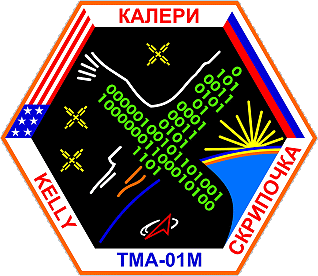 |
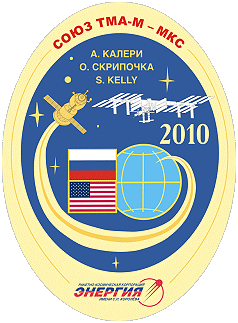 |
|
Copyright Roscosmos / Spacepatches.nl |
![]()
Launch, orbit and landing data
walkout photo |
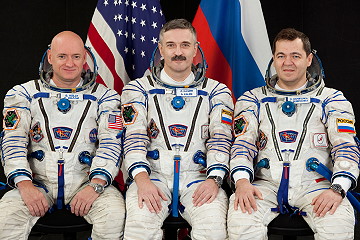 |
|||||||||||||||||||||||
alternative crew photo |
alternative crew photo |
|||||||||||||||||||||||
alternative crew photo |
alternative crew photo |
|||||||||||||||||||||||
alternative crew photo |
||||||||||||||||||||||||
Crew
| No. | Surname | Given names | Position | Flight No. | Duration | Orbits | |
| 1 | Kaleri | Aleksandr Yuriyevich | Commander | 5 | 159d 08h 43m 10s | 2509 | |
| 2 | Skripochka | Oleg Ivanovich | Flight Engineer | 1 | 159d 08h 43m 10s | 2509 | |
| 3 | Kelly | Scott Joseph | Flight Engineer | 3 | 159d 08h 43m 10s | 2509 |
Crew seating arrangement
|
 |
|
||||||||||||||||
Backup Crew
|
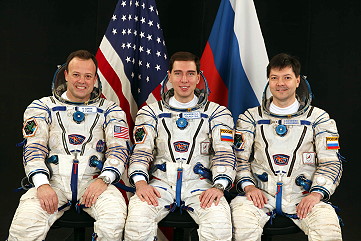 |
||||||||||||||||||||
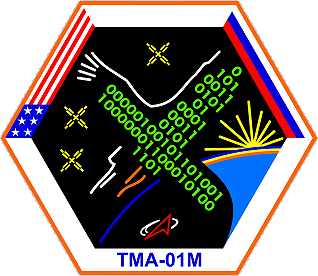 |
alternative crew photoalternative crew photo |
||||||||||||||||||||
|
Copyright Roscosmos / Spacepatches.nl |
Hardware
| Launch vehicle: | Soyuz-FG (No. 27M134S B15000-035) |
| Spacecraft: | Soyuz TMA-M (TMA-M No. 701) |
Flight
|
Launch from the Baikonur Cosmodrome. Landing
93 km north of Arkalyk. ISS Expedition
25 /
26. The Soyuz TMA-01M was the first Soyuz craft to use digital control systems. Following a two-day solo flight Soyuz TMA-01M docked to ISS on October 10, 2010. Aleksandr Kaleri, Oleg Skripochka and Scott Kelly became the ISS Expedition 25 (together with ISS Expedition 24 crew members Douglas Wheelock, Fyodor Yurchikhin and Shannon Walker). The Soyuz spacecraft is composed of three elements attached end-to-end - the Orbital Module, the Descent Module and the Instrumentation/Propulsion Module. The crew occupied the central element, the Descent Module. The other two modules are jettisoned prior to re-entry. They burn up in the atmosphere, so only the Descent Module returned to Earth. The deorbit burn lasted about 260 seconds. Having shed two-thirds of its mass, the Soyuz reached Entry Interface - a point 400,000 feet (121.9 kilometers) above the Earth, where friction due to the thickening atmosphere began to heat its outer surfaces. With only 23 minutes left before it lands on the grassy plains of central Asia, attention in the module turned to slowing its rate of descent. Eight minutes later, the spacecraft was streaking through the sky at a rate of 755 feet (230 meters) per second. Before it touched down, its speed slowed to only 5 feet (1.5 meter) per second, and it lands at an even lower speed than that. Several onboard features ensure that the vehicle and crew land safely and in relative comfort. Four parachutes, deployed 15 minutes before landing, dramatically slowed the vehicle's rate of descent. Two pilot parachutes were the first to be released, and a drogue chute attached to the second one followed immediately after. The drogue, measuring 24 square meters (258 square feet) in area, slowed the rate of descent from 755 feet (230 meters) per second to 262 feet (80 meters) per second. The main parachute was the last to emerge. It is the largest chute, with a surface area of 10,764 square feet (1,000 square meters). Its harnesses shifted the vehicle's attitude to a 30-degree angle relative to the ground, dissipating heat, and then shifted it again to a straight vertical descent prior to landing. The main chute slowed the Soyuz to a descent rate of only 24 feet (7.3 meters) per second, which is still too fast for a comfortable landing. One second before touchdown, two sets of three small engines on the bottom of the vehicle fired, slowing the vehicle to soften the landing. |
Graphics / Photos
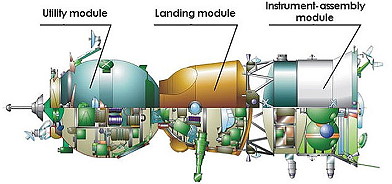 |
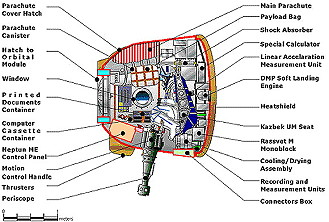 |
 |
 |
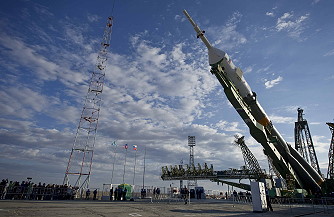 |
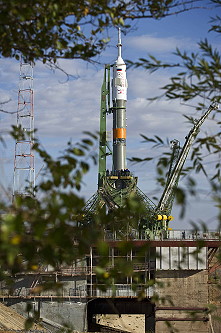 |
 |
 |
 |
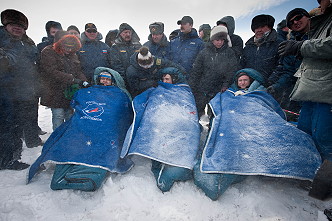 |
 |
| © |  |
Last update on March 29, 2020.  |
 |